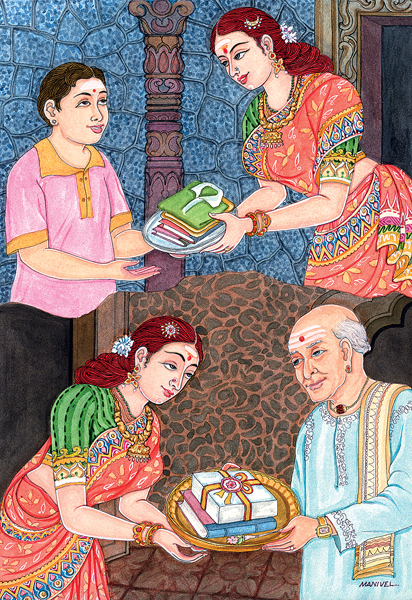|
Udayanacharya
Udayana, (Devanagari: उदयन) also known as Udayanācārya (Udyanacharya, or Master Udayana), (circa 975 - 1050 CE) was an Indian philosopher and logician of the tenth century of the Nyaya school who attempted to devise a rational theology to prove the existence of God using logic and counter the attack on the existence of God at the hands of Buddhist philosophers such as Dharmakīrti, Jñānaśrī and against the Indian school of materialism (Chārvaka). He is considered to be the most important philosopher of the Nyāya tradition. He worked to reconcile the views held by the two major schools of logic (Nyaya and Vaisheshika). This became the root of the Navya-Nyāya ("New Nyāya") school of the thirteenth century, established by the Gangesha Upadhyaya school of "right" reasoning, which is still recognized and followed in some regions of India today. He lived in Kariyan village in Mithila, near present-day Darbhanga, Bihar state, India. Udayana wrote a sub-gloss on V ... [...More Info...] [...Related Items...] OR: [Wikipedia] [Google] [Baidu] |
Udayanacharya Dih
Udayanacharya Dih is the site related to the Indian philosopher Udayana. The place is located at Kariyan village of Samastipur district in Mithila region of Bihar. There are ruins of Udayanacharya Dih. Udayana wrote his famous treatise Nyayakusumanjali at this place. Udayanacharya defeated the Buddhists scholars many times in debates during 10th century. Description The birthplace of the Indian philosopher Udayanacharya is at Karian village of Shivajinagar Block in Samastipur district of the Mithila region Mithila (), also known as Tirhut, Tirabhukti and Mithilanchal, is a geographical and cultural region of the Indian subcontinent bounded by the Mahananda River in the east, the Ganges in the south, the Gandaki River in the west and by the foothil .... His birth place at the village is called as Udayanacharya Dih or ''Udayan Dih''. According to legends it is said that the soil here is believed as a mixture of knowledge and wisdom. It is considered as holy soil. In the vill ... [...More Info...] [...Related Items...] OR: [Wikipedia] [Google] [Baidu] |
Kariyan
Kariyan or Karian is a village and a panchayat in Samastipur district in the Indian state of Bihar. Location About 12-km northeast of the Rosera ghat railway station of Northeastern Railways the modern village of Karian is situated on a mound, 20-ft high from the surrounding ground level and about 96 acres in area. Local traditions associate this village to be the birthplace of Udayanacharya, a Maithil Brahmin and great philosopher of ancient times who is also supposed to be an incarnation of Lord Vishnu. Extensive excavations have revealed at this village antiques of as back as of 2nd century B.C. and afterwards from 6th century AD to post 1200 A.D.This village is the birthplace of philosopher and scholar Udayana alias Udyanacharya This village is called the karmbhoomi of famous udyana who was a great philosopher and "shastarthi " in the time of Kumarilbhatta. It is said that both of udayanacharya and kumarilbhatta stop the expansion of Buddhism's in eastern India. Uda ... [...More Info...] [...Related Items...] OR: [Wikipedia] [Google] [Baidu] |
Hindu Philosophers And Theologians
Hindus (; ; also known as Sanātanīs) are people who religiously adhere to Hinduism, also known by its endonym Sanātana Dharma.Jeffery D. Long (2007), A Vision for Hinduism, IB Tauris, , pp. 35–37 Historically, the term has also been used as a geographical, cultural, and later religious identifier for people living in the Indian subcontinent. It is assumed that the term ''"Hindu"'' traces back to Avestan scripture Vendidad which refers to land of seven rivers as Hapta Hendu which itself is a cognate to Sanskrit term ''Sapta Sindhuḥ''. (The term ''Sapta Sindhuḥ'' is mentioned in Rig Veda and refers to a North western Indian region of seven rivers and to India as a whole.) The Greek cognates of the same terms are "''Indus''" (for the river) and "''India''" (for the land of the river). Likewise the Hebrew cognate ''hōd-dū'' refers to India mentioned in Hebrew BibleEsther 1:1. The term "''Hindu''" also implied a geographic, ethnic or cultural identifier for people l ... [...More Info...] [...Related Items...] OR: [Wikipedia] [Google] [Baidu] |
10th-century Indian Philosophers
1 (one, unit, unity) is a number, numeral, and glyph. It is the first and smallest positive integer of the infinite sequence of natural numbers. This fundamental property has led to its unique uses in other fields, ranging from science to sports, where it commonly denotes the first, leading, or top thing in a group. 1 is the unit of counting or measurement, a determiner for singular nouns, and a gender-neutral pronoun. Historically, the representation of 1 evolved from ancient Sumerian and Babylonian symbols to the modern Arabic numeral. In mathematics, 1 is the multiplicative identity, meaning that any number multiplied by 1 equals the same number. 1 is by convention not considered a prime number. In digital technology, 1 represents the "on" state in binary code, the foundation of computing. Philosophically, 1 symbolizes the ultimate reality or source of existence in various traditions. In mathematics The number 1 is the first natural number after 0. Each natural number, ... [...More Info...] [...Related Items...] OR: [Wikipedia] [Google] [Baidu] |
Karma
Karma (, from , ; ) is an ancient Indian concept that refers to an action, work, or deed, and its effect or consequences. In Indian religions, the term more specifically refers to a principle of cause and effect, often descriptively called the principle of karma, wherein individuals' intent and actions (cause) influence their future (effect): Good intent and good deeds contribute to good karma and happier Reincarnation, rebirths, while bad intent and bad deeds contribute to bad karma and worse rebirths. In some scriptures, however, there is no link between rebirth and karma. In Hinduism, karma is traditionally classified into four types: Sanchita karma (accumulated karma from past actions across lifetimes), Prārabdha karma (a portion of Sanchita karma that is currently bearing fruit and determines the circumstances of the present life), Āgāmi karma (future karma generated by present actions), and Kriyamāṇa karma (immediate karma created by current actions, which may y ... [...More Info...] [...Related Items...] OR: [Wikipedia] [Google] [Baidu] |
Vedas
FIle:Atharva-Veda samhita page 471 illustration.png, upright=1.2, The Vedas are ancient Sanskrit texts of Hinduism. Above: A page from the ''Atharvaveda''. The Vedas ( or ; ), sometimes collectively called the Veda, are a large body of religious texts originating in ancient India. Composed in Vedic Sanskrit, the texts constitute the oldest layer of Sanskrit literature and the oldest Hindu texts, scriptures of Hinduism. There are four Vedas: the Rigveda, the Yajurveda, the Samaveda and the Atharvaveda. Each Veda has four subdivisions – the Samhitas (mantras and benedictions), the Brahmanas (commentaries on and explanation of rituals, ceremonies and sacrifices – Yajñas), the Aranyakas (text on rituals, ceremonies, sacrifices and symbolic-sacrifices), and the Upanishads (texts discussing meditation, philosophy and spiritual knowledge).Gavin Flood (1996), ''An Introduction to Hinduism'', Cambridge University Press, , pp. 35–39A Bhattacharya (2006), ''Hindu Dharma: Introduc ... [...More Info...] [...Related Items...] OR: [Wikipedia] [Google] [Baidu] |
Pramana
''Pramana'' (; IAST: Pramāṇa) literally means " proof" and "means of knowledge".pramANa Sanskrit-English Dictionary, Koeln University, GermanyJames Lochtefeld, "Pramana" in The Illustrated Encyclopedia of Hinduism, Vol. 2: N-Z, Rosen Publishing. , pages 520-521 One of the core concepts in Indian , pramanas are one or more reliable and valid means by which human beings gain accurate, true knowledge. The focus of pramana is how correct knowledge can be acquired, how one knows, how one does not know, and to what extent knowledge pertinent about someone or something can be acquired.Karl Potter (2002), Presup ... [...More Info...] [...Related Items...] OR: [Wikipedia] [Google] [Baidu] |
Epistemology
Epistemology is the branch of philosophy that examines the nature, origin, and limits of knowledge. Also called "the theory of knowledge", it explores different types of knowledge, such as propositional knowledge about facts, practical knowledge in the form of skills, and knowledge by acquaintance as a familiarity through experience. Epistemologists study the concepts of belief, truth, and justification to understand the nature of knowledge. To discover how knowledge arises, they investigate sources of justification, such as perception, introspection, memory, reason, and testimony. The school of skepticism questions the human ability to attain knowledge while fallibilism says that knowledge is never certain. Empiricists hold that all knowledge comes from sense experience, whereas rationalists believe that some knowledge does not depend on it. Coherentists argue that a belief is justified if it coheres with other beliefs. Foundationalists, by contrast, maintain th ... [...More Info...] [...Related Items...] OR: [Wikipedia] [Google] [Baidu] |
Ontology
Ontology is the philosophical study of existence, being. It is traditionally understood as the subdiscipline of metaphysics focused on the most general features of reality. As one of the most fundamental concepts, being encompasses all of reality and every entity within it. To articulate the basic structure of being, ontology examines the commonalities among all things and investigates their classification into basic types, such as the Theory of categories, categories of particulars and Universal (metaphysics), universals. Particulars are unique, non-repeatable entities, such as the person Socrates, whereas universals are general, repeatable entities, like the color ''green''. Another distinction exists between Abstract and concrete, concrete objects existing in space and time, such as a tree, and abstract objects existing outside space and time, like the number 7. Systems of categories aim to provide a comprehensive inventory of reality by employing categories such as Substance t ... [...More Info...] [...Related Items...] OR: [Wikipedia] [Google] [Baidu] |
Nyaya Vaisesika
Nyāya (Sanskrit: न्यायः, IAST: nyāyaḥ), literally meaning "justice", "rules", "method" or "judgment", is one of the six orthodox ( Āstika) schools of Hindu philosophy. Nyāya's most significant contributions to Indian philosophy were the systematic development of the theory of logic, methodology, and its treatises on epistemology. Nyāya epistemology accepts four out of six ''pramanas'' as reliable means of gaining knowledge – ''pratyakṣa'' (perception), ''anumāṇa'' (inference), ''upamāna'' (comparison and analogy) and ''śabda'' (word, testimony of past or present reliable experts).John A. Grimes, A Concise Dictionary of Indian Philosophy: Sanskrit Terms Defined in English, State University of New York Press, , page 238DPS Bhawuk (2011), Spirituality and Indian Psychology (Editor: Anthony Marsella), Springer, , page 172 Gavin Flood, An Introduction to Hinduism, Cambridge University Press, , page 225 In its metaphysics, Nyāya school is closer to the Vai ... [...More Info...] [...Related Items...] OR: [Wikipedia] [Google] [Baidu] |
Mithila (region)
Mithila (), also known as Tirhut, Tirabhukti and Mithilanchal, is a geographical and cultural region of the Indian subcontinent bounded by the Mahananda River in the east, the Ganges in the south, the Gandaki River in the west and by the foothills of the Himalayas in the north. It comprises certain parts of Bihar and Jharkhand states of India and adjoining districts of the Koshi Province, Bagmati Pradesh and Madhesh Province of Nepal. The native language in Mithila is Maithili language, Maithili, and its speakers are referred to as Maithils. Mithila is commonly used to refer to the Videha Kingdom, as well as to the modern-day territories that fall within the ancient boundaries of Videha. Until the 20th century, Mithila was still ruled in part by the Raj Darbhanga. History In Jainism Mithilā is one of the most significant pilgrimage sites in Jainism. Apart from its association with ''Mahavira'', the 24th Tirthankara, it is also known for its association with ''Mallinatha'', ... [...More Info...] [...Related Items...] OR: [Wikipedia] [Google] [Baidu] |





